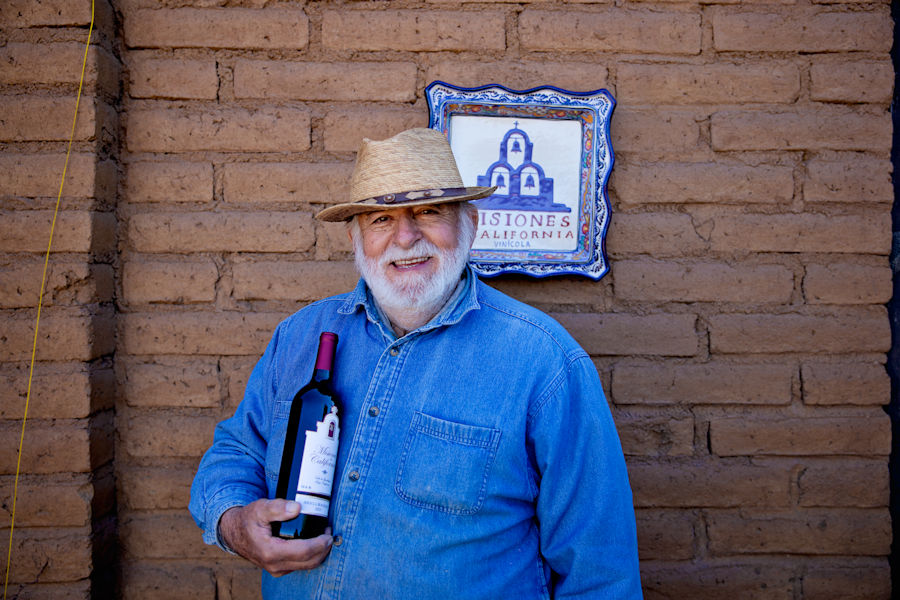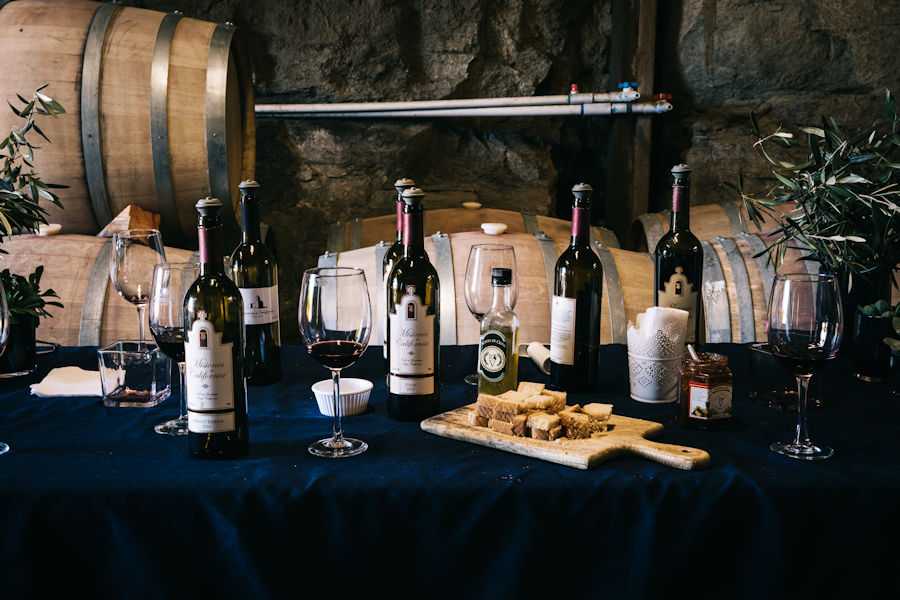 |  |
If you love wine and also love talking with the winemaker in a small and intimate cava tasting, Misiones de California is your destination. It’s a bright and sunny day after the rain and I follow the Ruta del Vino into the small town Antonio de las Minas. At the stoplight there is a necessary U turn. Watching the blue sign on the right, I turn onto a dirt road. A laid-back guard stops me, asking where I am going and waves me through with a smile. The road is rutted going past Santo Tomás and just beyond on the left is a large white sign announcing Rancho Velasco and Vinicola Misiones de California. A long single lane dirt road stretches out through an eighty year-old olive grove and disappears up over a hill. The vines are barren now, but beneath the rich soil, soaked by winter rains, life slumbers in their roots. Spring growth is right around the corner. The harvest will be good in 2020 for the winter has been cold and the rain a blessing.
Arriving at the rustic rancho, I’m met by bouncing puppies excited by a visitor. On the left is the tasting room carved into the hillside and is a humble representation of a small historic mission. Montserrat greets me and regrets her father will be unable to meet with us. She, the daughter of Raúl Velasco who first came here forty years ago, is the wine tasting guide for today. She brings me into the small cava where both stainless steel fermentation tanks and resting wine barrels are arranged. There is not much room for a large crowd which I prefer. For those that love a simple wine tasting in the vineyard sharing time with those passionate about wine making is a special treat.

I asked about her name, Montserrat. Her story about why her parents named her the way they did is a humorous one and we share a laugh over it. She tells me as she pours the first wine that her family grows the grape with great respect for the land and therefore their wines can be considered organic. There is quite an expensive and lengthy process to receive an official organic label; consequently Raúl has chosen not to go that route. The first red is young and does not pass through the barrel. It is a blend of Cabernet Franc, Nebbiolo and Syrah. It is fresh and fruity and easy to drink. Montserrat says, “We do this to encourage the Mexican people to try wine for the first time, because it’s uncomplicated and demands only to be enjoyed.” A lovely flowery aroma and a luscious note of strawberry preserves is easy and pleasing.
Raúl Velasco planted the vineyard in 2008. The vines, now 12 years old, have matured producing fine grapes. Part of this, Montserrat shares, is because of the way they tend the soil. “We try to pamper the land.” In this way they do nothing “aggressive” with chemicals. They adhere to no pesticide principle and fertilize with organics and seaweed. They are also one of the few wineries that utilize earthworms. These little creatures aureate the soil, feed on algae and bacteria in the soil, creating rich fertilizer castings. As the daughter of the winemaker, following in his footsteps, she smiles and says, “Like so many others, I went to the wine school here in the valley where my father went years ago. He made his first wine there, surprising everyone by winning first prize with his 2013 Cabernet Franc.” She pours a 2016 Mezcla Bordelesa, a blend of Cabernet Franc, Cabernet Sauvignon and Merlot. This wine is honest and very alive, having 14 months in American oak. Here is where the attention on organically grown begins to shine. Montserrat explains how each grape “moves differently in the mouth” from the first sip forward to the back of the mouth leaving a sensation of velvet on the tongue.

I ask how a father and daughter team work together. Montserrat laughs when she says, “We do confer with one another and I will tell him what I think as the wine comes close to bottling. But he is the one who knows what is happening inside the barrel. He is very patient with the grape and does not correct the grape once in the barrel. This does not happen often in many of the wineries, who will correct the direction the grape is taking and shows Velasco’s kindness through the whole process by not forcing the grape to express itself differently. The next presentation is a 100% 2017 Syrah with 12 months in American oak. I asked why winemakers blend, versus using the 100% of one varietal. Montserrat educates, “Because this is one way you begin to learn what each grape tastes like. With the Syrah, it is sweet and strong, gives richness and a long aftertaste. You can taste on your palate cherry, cacao and a hint of licorice. It is an exercise for the brain, to be able to pick out the flavors and name them.”
The final offering is a 100% Nebbiolo with 12 months in American Oak. Montserrat continues offering insights into winemaking. Nebbiolo is a dark and rich varietal; earthy like a dark forest where truffles might grow. She continues to describe the process, “As the grapes arrive from the vineyard, they first go through the de-stemming process, but the seed and skins are left on for the first fermentation. This gives the tannin levels to the wine. Then after the stainless fermentation the developing wine goes into the barrels. No one can see this happening, but she said her father knows exactly what goes on. I could tell how impressed she was with his knowledge. “We use the egg white for bringing clarity to the wine, as the egg white settles, it clears the sediment. It is a very old method not used much anymore.” This method is very labor intensive and only a handful of small production wineries have the time to clarify in this way. As I took my first taste of the Nebbiolo, I wanted to stay with it; I took the time to receive from the grape all that it had to offer. It was not something to rush through; the grape is a living thing. It wanted me to linger and enjoy it. Now this might sound odd, but winemakers talk about the grape as if it were a child. How does a child thrive? With gentle nurturing, patience and love. This makes for happy children and very happy wine.
Article by Martina
Photography by Cintia Soto

Easy to obtain, good quality, auto insurance for Mexico.

2nd year with Chubb. No problems

Great company and they use CHUBB which is a top notch insurance company.We got our policy online...